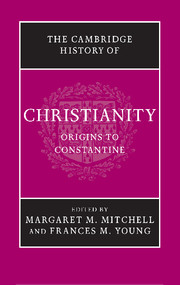Book contents
- Frontmatter
- Prelude: Jesus Christ, foundation of Christianity
- Part I The Political, Social and Religious Setting
- Part II The Jesus Movements
- Part III Community Traditions and Self-Definition
- Part IV Regional Varieties of Christianity in the First Three Centuries
- 15 From Jerusalem to the ends of the earth
- 16 Overview: the geographical spread of Christianity
- 17 Asia Minor and Achaea
- 18 Egypt
- 19 Syria and Mesopotamia
- 20 Gaul
- 21 North Africa
- 22 Rome
- Part V The Shaping of Christian Theology
- Part VI ‘Aliens’ become Citizens: towards Imperial Patronage
- Conclusion: retrospect and prospect
- Bibliographies
- Index
- Map 1. The Roman Empire in the time of Marcus Aurelius
- References
21 - North Africa
from Part IV - Regional Varieties of Christianity in the First Three Centuries
Published online by Cambridge University Press: 28 March 2008
- Frontmatter
- Prelude: Jesus Christ, foundation of Christianity
- Part I The Political, Social and Religious Setting
- Part II The Jesus Movements
- Part III Community Traditions and Self-Definition
- Part IV Regional Varieties of Christianity in the First Three Centuries
- 15 From Jerusalem to the ends of the earth
- 16 Overview: the geographical spread of Christianity
- 17 Asia Minor and Achaea
- 18 Egypt
- 19 Syria and Mesopotamia
- 20 Gaul
- 21 North Africa
- 22 Rome
- Part V The Shaping of Christian Theology
- Part VI ‘Aliens’ become Citizens: towards Imperial Patronage
- Conclusion: retrospect and prospect
- Bibliographies
- Index
- Map 1. The Roman Empire in the time of Marcus Aurelius
- References
Summary
‘Africa’ here refers to the land north of the Sahara, excluding Egypt and Ethiopia, but including modern-day Morocco, Algeria, Tunisia and western Libya. In this vast expanse of land, Christianity grew and provided the larger church with a bounteous crop of theological reflection. The roots of contemporary ecclesiology and sacramental theology, as well as traditions of biblical interpretation, were nourished here.
The evidence
Literary evidence for Christianity in North Africa in the first three centuries comes from Tertullian (c.160–c.225 ce), Minucius Felix (second/third century), Cyprian (d. 258), Commodian (fl. mid-third century), Pseudo-Cyprian (post- 258), and various homilies and stories of martyrdom. It illustrates the beliefs of the Christian communities, their structures and practices.
There are many archaeological sites in Africa, but none provides direct testimony of Christianity’s early years. Not even Carthage boasts pre-fourth-century evidence. The principal obstacle to investigations into the earliest years is the fact that the churches were repeatedly rebuilt, especially during the post-Vandal conquest.
The earliest literary references to buildings used for Christian worship are all from the fourth century. The Gesta apud Zenophilum (320) mentions ‘the house in which Christians gathered’ in 303 ce. The Martyrium Saturnini (304 ce or shortly thereafter) mentions gathering in a lector’s home during the Diocletianic persecution after the bishop’s defection. An inscription at Altava (309 ce) tells of a basilica dominica (‘dominical hall’), a shrine commemorating a martyr. Gallienus’ edict restoring previously confiscated churches (Euseb. HE 7.13) finds no echo of application in Africa.
Keywords
- Type
- Chapter
- Information
- The Cambridge History of Christianity , pp. 380 - 396Publisher: Cambridge University PressPrint publication year: 2006
References
- 1
- Cited by



